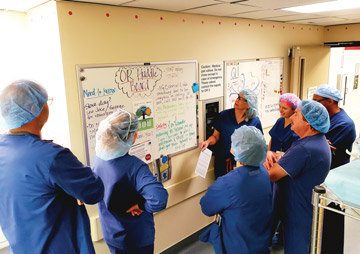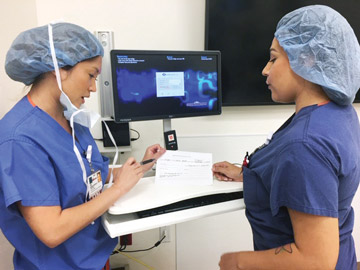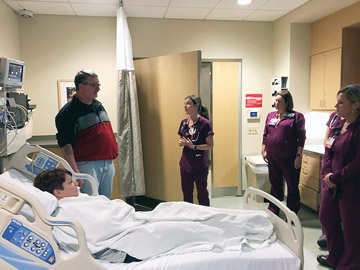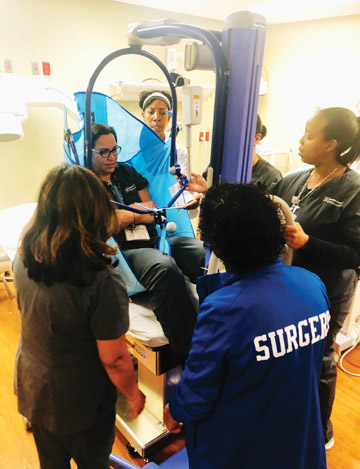Six Surface Disinfection Concepts
The puzzle of superior surface disinfection is never solved....
This website uses cookies. to enhance your browsing experience, serve personalized ads or content, and analyze our traffic. By clicking “Accept & Close”, you consent to our use of cookies. Read our Privacy Policy to learn more.
By: Adam Taylor
Published: 9/11/2019
Baptist Hospital in Miami, Fla., this year’s winner of the 2019 OR Excellence Award for Employee Safety, is well on its way to clearing the OR air of surgical smoke thanks to the efforts of several nurses in training.
“A group of nursing residents conducted an evidence-based project on how working in a smoke-free health system would protect our staff,” says Rachel Evers, MSN, RN, CNOR, Baptist Hospital’s director of surgical services. “They presented it at our hospital fair. Nurse educators saw the presentation and told our directors about it.”
A smaller Baptist Health facility trialed a smoke-evacuation product, purchased it and now uses it during all procedures. Baptist Hospital, which has 24 ORs, is trialing 2 devices now and expects to be completely smoke-free in the near future.
Ms. Evers says how the idea came to be is an important part of what makes the safety practices at Baptist Health tick. “It came from the bedside,” she says.
It’s likely that the hospital will select the device already in use at the smaller facility in the health system, as standardization of equipment is a goal of Baptist Health’s perioperative directors.


“PAS means Problem And Solution, and that’s all it means,” says Ms. Cisneros, nurse manager of outpatient surgery & pre-admit testing at Pomona (Calif.) Valley Hospital Medical Center. “No blame. No pointing fingers. It’s not an incident report. Nothing punitive comes from it.”
Team members are often reluctant to put safety issues in writing for fear of getting others or themselves in trouble, or are too busy to bring potential problems to a supervisor’s attention. The PAS sheet helps managers hear about issues soon after they occur.

“In addition to being cost effective and efficient, having the same equipment at each facility makes sense for a lot of reasons,” says Ms. Evers. “If we ever need to borrow from each other, it’s already in the system, it’s easy to find and the surgeons are familiar with how it works.”

The trialing process is as simple as testing out devices when they arrive, says Ms. Evers. The trickier part of the process is finding a doctor who will champion its regular use. “We work with a physician who is willing to rally other doctors together and speak positively about smoke evacuation,” she adds.
Staff educators and frontline nurses also lobby for and promote smoke evacuation.
Education is also a key component of adding a new piece of equipment. Baptist Health used the AORN guidelines for surgical smoke safety as the foundation of its campaign to explain why smoke evacuators were being considered and how they would create safer working environments for the OR staff. They also displayed the poster created by the residents who began the campaign.
The transition has not met with any resistance so far. “I think anyone understands this is being done for their safety,” says Ms. Evers.
Baptist Hospital has a changing population, many of whom are wheelchair-bound, which has led the staff to rely on the expertise of the hospital’s patient handling coordinator more often than it did in the past. The new influx of cancer patients and those who suffer from spinal muscular atrophy, a rare neuromuscular disorder, come to the hospital for pain management injections and treatments. Transferring some of the patients from the wheelchair to the bed is difficult, so the patient handling coordinator facilitated the purchase of a lift that helps transfer patients who weigh up to 700 pounds.
“The coordinator saw what we were dealing with, looked at how we were moving the patients, and suggested the lift because it was best for not only our patients, but also for the safety of our staff,” says Ms. Evers. “The coordinator is hands-on, watches the staff use the lift and makes sure it’s being used safely and correctly.”
Each Baptist Health OR has lateral transfer devices to help staff move patients from stretchers to the table. Every available staff member is expected to answer pages and go to where one of their colleagues needs help transporting a patient. Members of the leadership team also help move patients from time to time.
“We roll up our sleeves and help the people who do it every single day,” says Ms. Evers. “I can’t ask them to do things I’m not willing to do.”
Baptist Health has a Code Sharp system that reviews staff injuries from needles and other sharps in order to determine how they can be prevented in the future. A response team is paged if an unsecured sharp is detected or if a staff member gets stuck. The team removes the sharp and sends the employee for treatment.
The staff gathers for regular patient safety meetings that serve as good vehicles to address staff safety, because there is often an overlap.
“If someone has an issue with a new syringe, and we’re noticing the capping isn’t working, those meetings are a good time to see if other people are having the same difficulties,” says Ms. Evers. “Then we can find out if it’s an isolated or a global issue, and whether the solution is to educate the staff on how to use it, or if it’s something that needs to be brought to the vendor’s attention.” OSM

The trialing process is as simple as testing out devices when they arrive, says Ms. Evers. The trickier part of the process is finding a doctor who will champion its regular use. “We work with a physician who is willing to rally other doctors together and speak positively about smoke evacuation,” she adds.
Staff educators and frontline nurses also lobby for and promote smoke evacuation.
Education is also a key component of adding a new piece of equipment. Baptist Health used the AORN guidelines for surgical smoke safety as the foundation of its campaign to explain why smoke evacuators were being considered and how they would create safer working environments for the OR staff. They also displayed the poster created by the residents who began the campaign.
The transition has not met with any resistance so far. “I think anyone understands this is being done for their safety,” says Ms. Evers.
The puzzle of superior surface disinfection is never solved....
Boston Children’s Hospital is renowned for its exemplary care on many fronts, including surgery....
Manual cleaning done properly is effective for eradicating microorganisms....